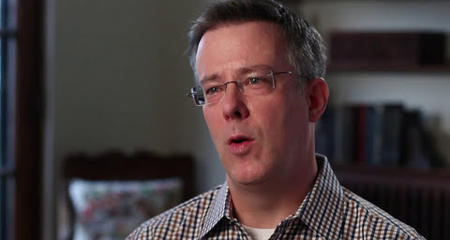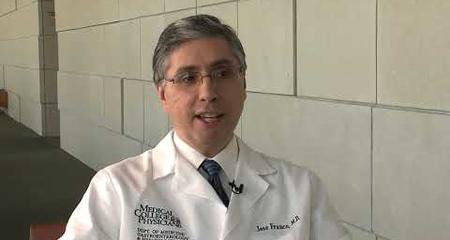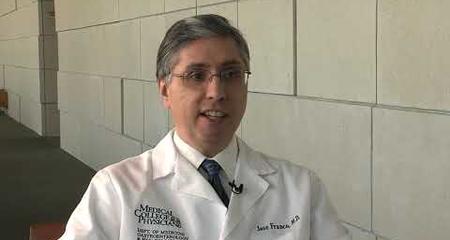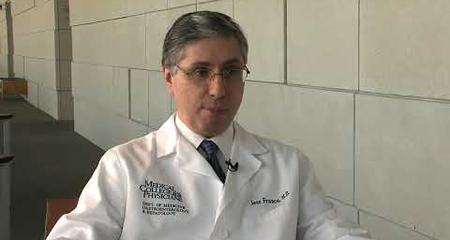The Gastroenterology/Hepatology Program excels in performing advanced endoscopy and other non-surgical treatments for disorders of the digestive tract. These treatments do not preclude surgery, if required. Gastroenterologists and hepatologists work with surgeons to determine the optimal treatments for patients.
Endoscopy treatment includes the use of endoscopic retrograde cholangiopancreatography (ERCP) and endoscopic ultrasound (EUS), which are also used to diagnose digestive tract problems. If certain disorders are found during an ERCP or EUS evaluation, it’s often possible to treatment them at the same time.
Treatment with Endoscopic Retrograde Cholangiopancreatography (ERCP)
ERCP combines X-rays with an endoscope — a long, flexible, lighted tube. A dye is injected into the ducts so they can be seen on the X-rays. The endoscope is advanced through the mouth and into the small bowel to view the ducts from the liver and pancreas.Treatment is often done as part of an ERCP examination. For example:
- If the exam shows a gallstone in a bile duct, the physician can insert instruments into the endoscope to remove the stone.
- If an abnormal growth is seen, an instrument can be inserted through the endoscope to obtain a sample (biopsy) of the tissue for further testing.
- If the exam shows a narrowed bile duct, a stent (a small tube) can be inserted through the endoscope and into the duct to open it.
ERCP guidance may be used to treat:
- Pancreatitis (inflammation of the pancreas)
- Tumors of the pancreas, bile ducts, gall bladder and liver
- Blockage of the bile duct (gallstone, tumor, scarring or other condition that causes obstruction or narrowing [stricture] of the ducts)
- Blockage of the pancreatic ducts (stones, tumors or strictures)
- Cysts in the pancreas and bile ducts
- Pancreatic and bile duct leaks (caused by trauma or surgery)
- Gastric outlet obstruction (an obstruction of the channel through which the stomach empties its contents)
Treatment with Endoscopic Ultrasound (EUS)
EUS uses an endoscope that contains a small ultrasound transducer, allowing ultrasound imaging to get close to the inside of the digestive tract.
EUS guidance may be used to:
- Acquire tissue samples
- Ablate (destroy) a cyst
- Drain fluid collections in and around the pancreas (pseudocyst drainage)
- Locate tumors to guide an ablation procedure
- Perform fine-needle injection therapy of cancer drugs
- Perform a celiac nerve block, an injection to destroy the nerves behind the pancreas to relieve pain due to pancreatic cancer
- Alleviate an obstruction in the pancreaticobiliary tract and bowel
Endoscopic Treatment of Esophageal Motility Disorders
Two major treatments are available for the treatment of esophageal motility disorders. The first is pneumatic dilation of the lower esophageal sphincter in patients with esophageal achalasia. This involves the passage of a large diameter balloon to the level of the lower esophageal sphincter and stretching this sphincter muscle while the patient is sedated. This is an outpatient procedure that is successful in the majority of patients with achalasia and avoids the need for surgery.
The second major treatment is the injection of botulinum toxin into the esophagus to treat achalasia and spastic disorders of the esophagus. This is also an outpatient procedure. After several months, patients usually require repeat treatments.
Advanced Therapeutic Endoscopy
Highly skilled and experienced Medical College of Wisconsin gastroenterologists/hepatologists perform a variety of advanced endoscopic procedures to treat disease. These include:
Treating Sphincter of Oddi Dysfunction
Endoscopy is used to evaluate and treat dysfunction of the sphincter of Oddi (SOD), the muscle fibers surrounding the exit of the bile duct and pancreatic duct into the small intestine. This sphincter muscle controls secretions from the liver, pancreas and gallbladder into the small intestine.
Normally, the sphincter muscle functions as a one-way valve to allow bile and pancreatic secretions to enter the intestine. When this muscle malfunctions, the pancreatic and bile ducts cannot drain adequately. This may lead to pancreatitis or biliary pain.
To diagnose SOD, manometry is performed by placing an endoscope into the upper intestine. A catheter is passed into the sphincter through the endoscope. If pressure readings suggest SOD dysfunction, the sphincter may be cut through the endoscope. This procedure, called a sphincterotomy, requires extensive endoscopic experience. Medical therapy may also be used in treatment.
Stent Placement
Stents (hollow tubes) can be placed in many areas of the digestive tract to open obstructions caused by strictures (narrowing of a duct), stones, tumors or other problems. Stents are used in treatment, as a bridge to surgery, and for palliative care to relieve symptoms caused by cancer.
Stents can be placed in the bile ducts, bowel, rectum, pancreas, esophagus, stomach and small intestine. Many patients at other area hospitals are referred to the Gastroenterology/Hepatology Program at Froedtert & the Medical College for these highly specialized stenting procedures.
Specialized endoscopic stenting procedures are performed to treat:
- Transesophageal fistula: using advanced endoscopy to place a stent to seal a transesophageal fistula, an abnormal connection between the esophagus and the trachea, which may cause food and drink to enter the lungs.
- Perforated esophagus: if the esophagus is perforated (pierced), such as during surgery, Froedtert & the Medical College gastroenterologists have the expertise to seal the perforation with a removable stent, avoiding the need for emergency surgery.
- Gastric outlet obstruction: a procedure to place a stent in the gastric outlet, the channel that allows the stomach to empty. The stent can relieve gastric outlet obstruction (caused by cancer), relieving symptoms and restoring the ability to eat.
Recognized as High Performing by U.S. News & World Report
Froedtert Hospital is recognized by U.S. News & World Report as high performing in three adult specialties and 16 procedures and conditions, including gastroenterology and GI surgery.Virtual Visits Are Available
Safe and convenient virtual visits by video let you get the care you need via a mobile device, tablet or computer wherever you are. We'll assess your condition and develop a treatment plan right away. To schedule a virtual visit, call 414-777-7700.





